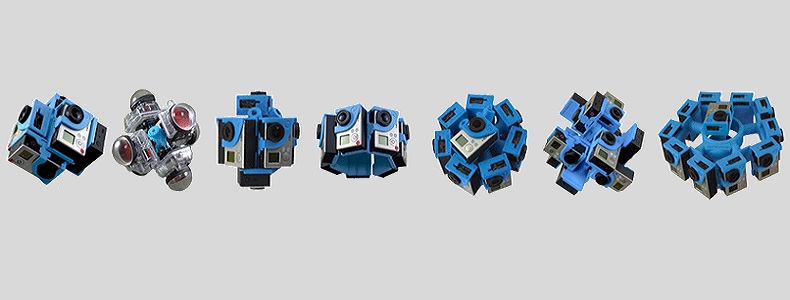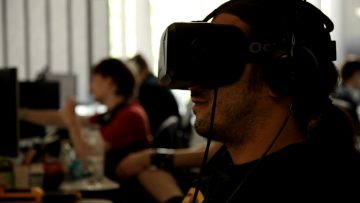
VR Vs. Facebook, 360 Degree Video & The Great Explainer
When is virtual reality not virtual reality? What VR is depends in many ways on who you ask of course. To the enthusiast VR is a 3D computer environment or simulation, with degrees of interactivity and a specific of technical benchmarks. To the pessimist it’s a fad, a joke of the past. To some it is the future, of where technology is taking us, whilst to others it is the present and an exciting time we’re living through. And, indeed, there are those still to whom VR is ‘that thing off of Star Trek’ and VR will not ‘be’ VR until we have working Holodecks and can get into all sorts of trouble with Professor Moriarty.

I’ve been with VRFocus for over a year now, and though you don’t hear from me all that much since I’m more often than not found over on the social channels, one thing I’ve seen there is that there are quite a few people that will answer “360 degree video” to that question. It’s somewhat surprising, but there is a definite percentage of people out there to whom discussing 360 degree video as VR is something of an insult. It is wrong to say 360 video is VR, ourselves and other technology outlets should refrain from linking the two and in some cases everyone should stop talking about it altogether.
It’s all, well… rather odd.
I say this as someone who admittedly isn’t that technically minded, but while I see that (technically) there is a difference, at the end of the day does it really matter? Does it cheapen VR at all if 360 degree photos and videos are a part of the experience? Not really, because ultimately… who cares? It seems so strange that for a technology that needs people to see it to truly ‘get it’, something I think we’re pretty much all agreed on at this point, that people would be so against what is arguably one of the easiest ways for someone to see that potential. 360 degree videos are a great way to show VR headsets off. They’re the next stage of recording and reporting; not just seeing what happened, but getting as close to people being there as they can – at least until said Holodeck.
It is a selling point for systems, and a fixture of promotional materials, notably for Samsung and the Gear VR which has been promoting 360 degree video and its own related services. It is also something that you can see without owning a head-mounted display (HMD). People can look at the video without one and understand how it would work with one. Regardless of its technical status, it is a showcase, a great explainer of what VR can do. It’s why I created the Life in 360° series to show off the huge variety of things that people are already doing with it, as well as having something quick and fun in the mornings for everyone.
As a format, 360 video is here to stay and adoption is only going to speed up. There are a number of reasons for this, and certainly the advancement of camera technology is amongst them. Whilst early 360 degree videos had a tendency to look like you’re squinting through a bunch of gauze, you can now get off the shelf 360 degree recording solutions capable of 4K video quality. Cameras like the PIXPRO SP360 for instance from Kodak. So you now have companies battling to produce the technology for a commercial level, not just a professional one which will only lead to innovation, refinement, and a reduction in retail cost. On that professional side you’ve got companies like Jaunt, Nokia with the Ozo and now Facebook themselves throwing their weight behind the hardware side with the Facebook Surround 360, it’s all helping the medium get a foothold in the various areas of our lives. We’ve reported many times on VR’s spread into the fields of factual reporting and entertainment. We’ve seen both journalists taking up the medium to help show the bigger picture in a quite literal sense and film makers discuss it as a new and exciting field. Media firms are acquiring studios, scrambling to not get caught out as they did at the start of the online video boom (something we’ll discuss on VR Vs another week).

But in many ways the Facebook Surround 360 is more important from a perception point of view. Setting aside Facebook’s established connections to the VR industry with Oculus, in the modern online world the company Mr. Zuckerberg built is one of the biggest influencers in our lives on a global scale. Their brand being directly (as opposed to indirectly through owning Oculus) involved brings credibility and awareness to the technology; as of course so does their online support for the video format itself. YouTube is, naturally, the biggest video platform out there. But Facebook cannot be denied either, hitting 8 billion daily views at the end of 2015, 100 million hours viewed per day at the beginning of the year. Combined with YouTube that’s a lot of eyeballs that have the potential to view 360 degree videos.
So to summarise you have huge media platforms supporting the videos and a technology that is becoming increasingly adopted and more readily available. The fact is that if the VR pessimists were declared right, that VR was just a fad and everything somehow magically stopped tomorrow, then 360 degree video would still be around. It is something anyone can enjoy. Something most anyone can create, and is easy to understand the concept of. No, 360 degree video isn’t technically the same but it is effectively the same. Each helps the public understand and enjoy the other. So if you are a person enraged that 360 is mentioned in the same breath as VR it’s probably time you swallowed your pride and accept it, because it is only your pride – and not VR – that is being hurt by it.
This article was originally written by the author for VRFocus.






